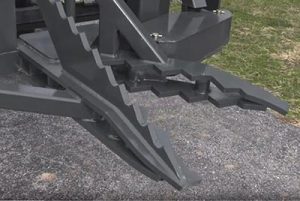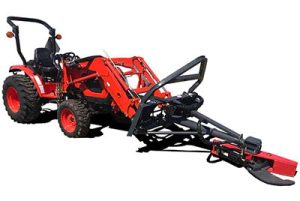The Gator Tree Puller
“Because sometimes it just feels better to yank the whole tree out of the ground; roots and all!”
A Tree Puller Versus a Tree Shear
A tool that I find really handy around my place is a tree puller, a device that goes on front of the tractor. You must have front hydraulic remote connections on the front of your loader to use a tractor tree puller. You just squeeze the prongs of the puller together around the base of a tree, lift up your loader, and lift the tree right out of the ground.
It’s pretty slick, and I’m going to tell you the advantages of this tool today. But I’ll also lay out the disadvantages, because there are a few.
A Tree Puller Yanks The Entire Tree Out
The number one thing I like about the Gator tree puller for a tractor is that you’re pulling the entire tree out of the ground. Now, you might leave a few roots around, but you’re pulling the bulk of the tree out. There’s no stump left at all. And it’s really great that you’re not having to use chemicals to keep a left-behind stump from future sprouting.
Now, will it stump-sprout from the roots that you leave behind? You may get all the roots, but there’s a lot of trees – depending on the variety – where you leave a few roots sticking out of the ground. I think a lot depends on the variety of tree you’re pulling down.
But the number one advantage is you’re getting everything out and doing it with one pull.
A Tree Puller Gives You More Control Than a Shear
The second advantage of a tree puller for a tractor loader versus a tree shear is control. When you’re pulling a tree out you’ve got it clamped in your puller jaws. So if you want to move it over to a burn pile, you just run over there and drop it in the burn pile. You only handle it once, and I find that to be a huge advantage, especially when I’m cutting stuff that’s nasty with thorns of some kind. (Think thorny locust trees or multiflora rose bushes, for example.) With the tree puller you can easily drag them off where they need to go and not have to go near them again.
Really Great Along Fence Rows
The next thing I like about this tool, and where I’m going to be using this tool a lot, is fence rows. I struggle with keeping fence rows clean, and the tree puller’s teeth are low enough that they’ll go under most of my fence rows. They clamp on to whatever I want to remove, and then I can work them back up and pull the unwanted plants out. If you have a fence row that maybe you cleaned up five years ago and things have re-sprouted, this is the tool you need. I really like being able to go under fence rows to get things cleaned up nice.
I’ll agree that with a tree shear you can go under fence rows as well. But sometimes those trees are kind of mangled into the fence and you have to hand pull them out. This tool lets you pull them out of the fence and take them away.
The Tree Puller Doesn’t Disturb the Soil
Another feature of the tree puller that I really like is that it doesn’t disturb the soil very much. I like to come out in either the fall or the late winter to pull those trees out of the ground. Then I have the winter and the spring rains to redistribute the soil. You don’t have much of a hole left once you’ve yanked out a tree, although sometimes you’ve got to shake the tree a little bit to get the dirt ball off. Then the soil settles, the grass comes up, and you can’t notice where you pulled that tree.
Tree Pullers Can Grab Those Grape Vines Off the Trees
I have a problem with grapevines, huge grape vines, and the tree puller can pull those vines right out of the tree they’re in and haul them to the burn pile. In the time of year when leaves are off the trees, pulling the vines won’t damage the tree by grabbing its leaves.
Hardened Teeth on This Tree Puller
Here’s another thing I like about this particular tree puller: It has hardened teeth on the end of it. If you encounter a tree a little too big to pull, you can actually plunge these into the ground and try to sever some of the roots and then pull it out.
of it. If you encounter a tree a little too big to pull, you can actually plunge these into the ground and try to sever some of the roots and then pull it out.
And I wouldn’t have a problem using the skid loader or tractor to pull it out at that point. But if you get too involved trying to pull bigger trees out and dig the ends of the puller deep into the ground, you can tweak your loader frame. That’s true especially if you back up and then take a run at it. The tree puller isn’t really designed for that. But say the tree is just on the marginal end of being able to pull it out. Then you might be able to cut one or two roots and yank it out with the puller.
And You Can Move Rocks, Too
I’ve discovered that if I’ve got something to move around, say a fair-sized rock, I can do that with the tree puller, too. I just pull the jaws together until they clamp on the rock and move it away. So you use it to grab odd-type stuff and move it where you need it.
And Now the Disadvantages
My video viewers always ask me how big a tree this tool will actually pull out. And honestly, I can’t tell you.
It depends on your tractor size, and more so, on the soil conditions, and the tree variety. Those variables limit us, so we can’t just say a certain sized tractor can pull out a certain sized tree. Tree pullers work best (and really work, period) when there’s been some moisture and the ground is loose. In my area when we’ve had a drought, I don’t think this tool going to work at all. But once the weather changes and we’ve rain or snow, I can pull trees just fine.
Bottom line, then, is you can’t use this tool all the time and you can’t predict what size tree you can remove.
Tree Size and Root System Also Matter
But having said that, I notice a big difference in which trees can be pulled. Some trees are easy to pull out of the ground and others are harder. It depends on the root system. A tree with a small root ball might just pop out of the ground, but an elm tree with roots going everywhere may be too much. Most of my bigger trees I’ll just cut with a chain saw.
And Too Small Is Too Hard, Too
Another disadvantage of a tree puller is that the smaller stuff may not come out of the ground. If it’s really small material, the teeth may just slide up the stalk and mark it up a little bit. Still, this locks pretty well on a lot of trees and small shrubs, so you’ll just have to experiment and see what will and won’t pull.
Also, if you have a dead tree you’re trying to pull out by the roots, it may break it off. I’ve seen that more than I have seen the tool sliding up the bark, but either is possible.
The Puller Vs. The Mini Clip Tree Shear
The last disadvantage of this tool versus the Mini Clip tree shear for tractors, also available here, is that the Mini Clip can go up in the air  and rotate to cut limbs. Of course, you can’t do that with a tree puller.
and rotate to cut limbs. Of course, you can’t do that with a tree puller.
While you’re just pulling with this tool, the Mini Clip tractor tree shear does a great job of going up and clipping up in the air as well as down on the ground. So if you want to prune your trees and cut the undesirables, you can do that with the Mini Clip. With the puller, you’re digging stuff out of the ground.
So in the end, you probably need to determine what you’re planning to remove. A lot of small stuff, a lot of fence row, grapevines and thorny stuff…the tree puller removes it and hauls it right to the burn pile. I confess I take great pride – and get great excitement– pulling a thorn tree or a multiflora rosebush clump out of the ground and taking it to the burn pile where I make it go away forever. Going forward, I think it will help me really clean up my place. But if I had 20 acres of total brush and needed to get it done, a tractor tree cutter might be a better option for that. If you’re looking for a tractor tree shear for sale, click here.
